KIA Sportage 2005 JE_ / 2.G Owner's Manual
Manufacturer: KIA, Model Year: 2005, Model line: Sportage, Model: KIA Sportage 2005 JE_ / 2.GPages: 354, PDF Size: 2.78 MB
Page 311 of 354
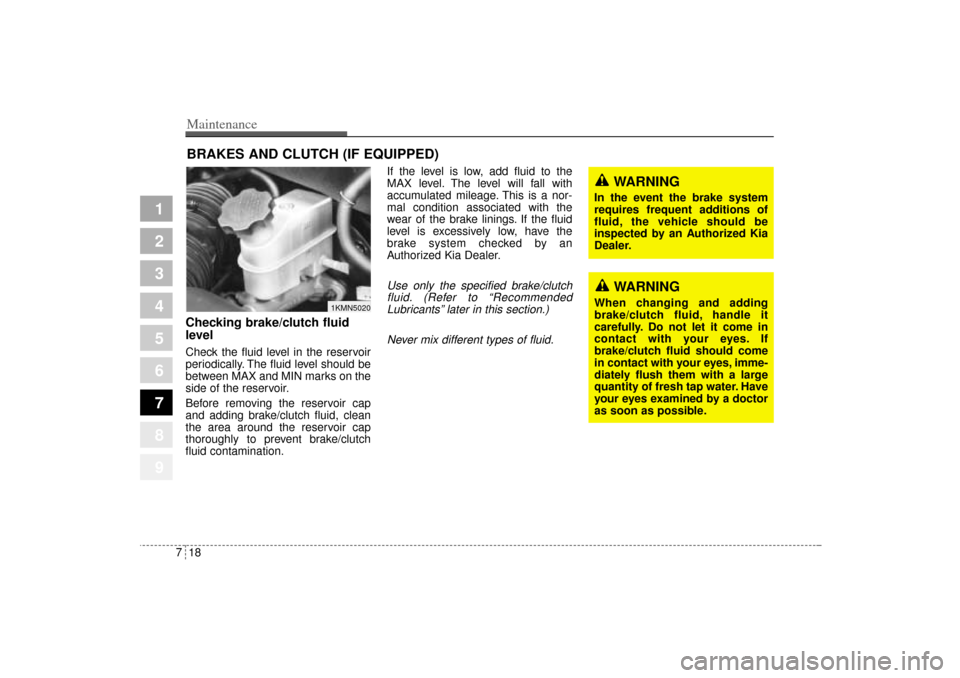
Maintenance18 7
1
2
3
4
5
6
7
8
9
BRAKES AND CLUTCH (IF EQUIPPED)Checking brake/clutch fluid
level Check the fluid level in the reservoir
periodically. The fluid level should be
between MAX and MIN marks on the
side of the reservoir.
Before removing the reservoir cap
and adding brake/clutch fluid, clean
the area around the reservoir cap
thoroughly to prevent brake/clutch
fluid contamination.If the level is low, add fluid to the
MAX level. The level will fall with
accumulated mileage. This is a nor-
mal condition associated with the
wear of the brake linings. If the fluid
level is excessively low, have the
brake system checked by an
Authorized Kia Dealer.
Use only the specified brake/clutch
fluid. (Refer to “Recommended
Lubricants” later in this section.)
Never mix different types of fluid.
WARNING
When changing and adding
brake/clutch fluid, handle it
carefully. Do not let it come in
contact with your eyes. If
brake/clutch fluid should come
in contact with your eyes, imme-
diately flush them with a large
quantity of fresh tap water. Have
your eyes examined by a doctor
as soon as possible.
WARNING
In the event the brake system
requires frequent additions of
fluid, the vehicle should be
inspected by an Authorized Kia
Dealer.
1KMN5020
KM CAN (ENG) 7.qxd 9/13/2004 4:47 PM Page 18
Page 312 of 354
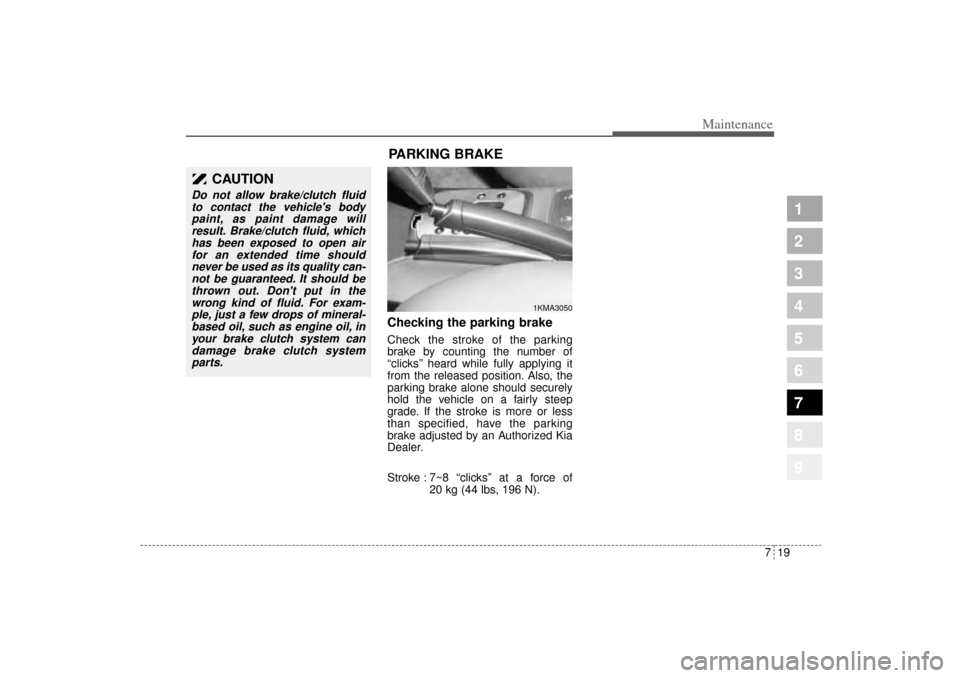
719
Maintenance
1
2
3
4
5
6
7
8
9
Checking the parking brake Check the stroke of the parking
brake by counting the number of
“clicks’’ heard while fully applying it
from the released position. Also, the
parking brake alone should securely
hold the vehicle on a fairly steep
grade. If the stroke is more or less
than specified, have the parking
brake adjusted by an Authorized Kia
Dealer.
Stroke : 7~8 “clicks’’ at a force of
20 kg (44 lbs, 196 N).
1KMA3050
PARKING BRAKE
CAUTION
Do not allow brake/clutch fluid
to contact the vehicle's body
paint, as paint damage will
result. Brake/clutch fluid, which
has been exposed to open air
for an extended time should
never be used as its quality can-
not be guaranteed. It should be
thrown out. Don't put in the
wrong kind of fluid. For exam-
ple, just a few drops of mineral-
based oil, such as engine oil, in
your brake clutch system can
damage brake clutch system
parts.
KM CAN (ENG) 7.qxd 9/13/2004 4:47 PM Page 19
Page 313 of 354
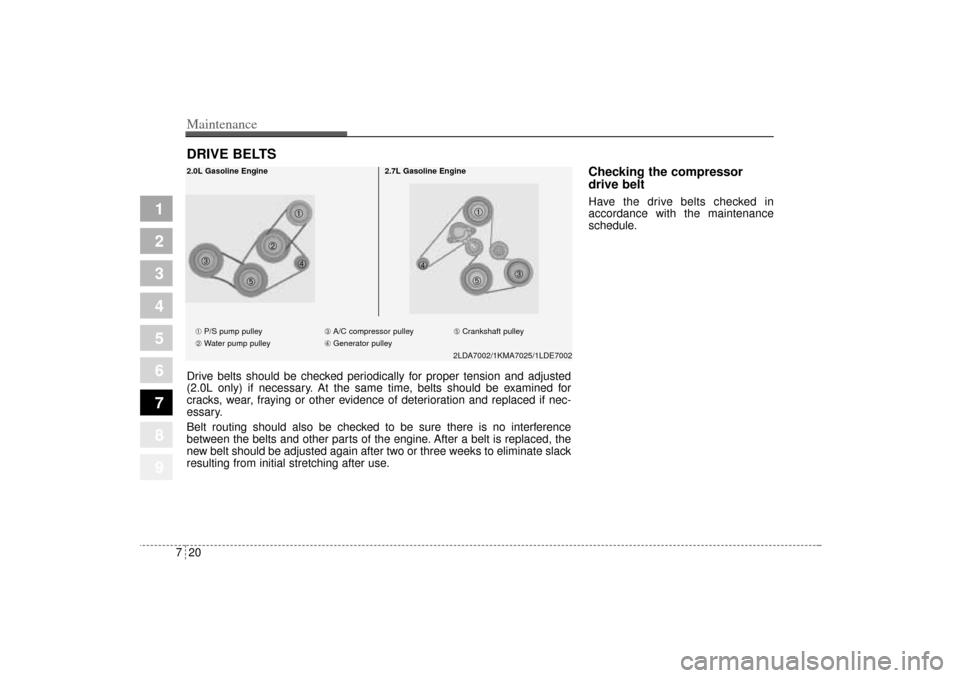
Maintenance20 7
1
2
3
4
5
6
7
8
9
DRIVE BELTS
Checking the compressor
drive beltHave the drive belts checked in
accordance with the maintenance
schedule.
2LDA7002/1KMA7025/1LDE7002 ➀ P/S pump pulley
➁ Water pump pulley➂ A/C compressor pulley
➃ Generator pulley➄ Crankshaft pulley
2.0L Gasoline Engine 2.7L Gasoline Engine
➀➀
➃
➃ ➁
➄➄ ➂
➂
Drive belts should be checked periodically for proper tension and adjusted
(2.0L only) if necessary. At the same time, belts should be examined for
cracks, wear, fraying or other evidence of deterioration and replaced if nec-
essary.
Belt routing should also be checked to be sure there is no interference
between the belts and other parts of the engine. After a belt is replaced, the
new belt should be adjusted again after two or three weeks to eliminate slack
resulting from initial stretching after use.
KM CAN (ENG) 7.qxd 9/13/2004 4:47 PM Page 20
Page 314 of 354
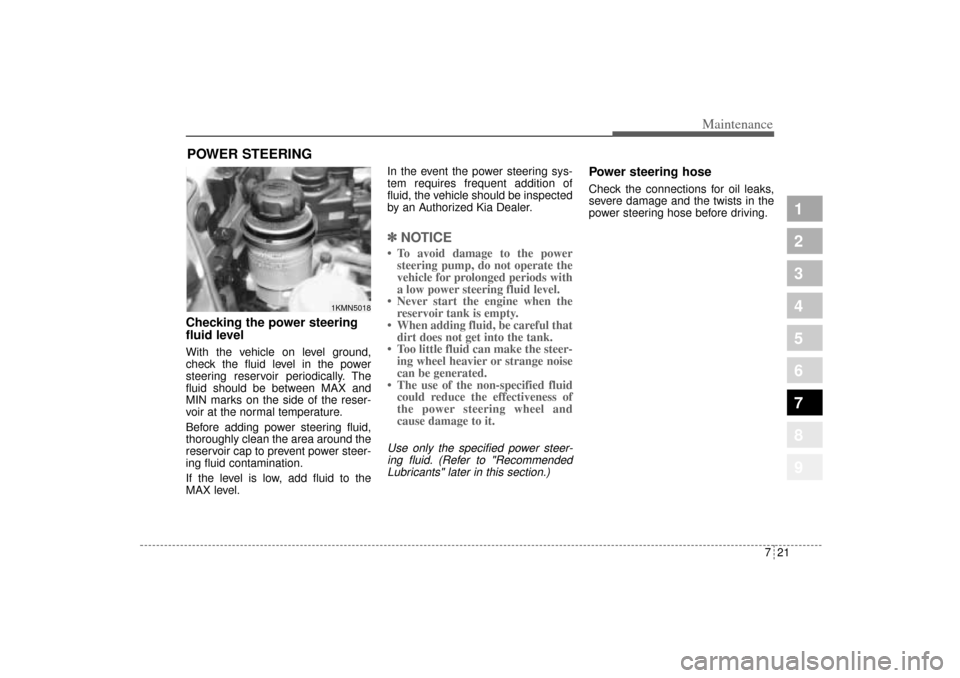
721
Maintenance
1
2
3
4
5
6
7
8
9
POWER STEERING Checking the power steering
fluid level With the vehicle on level ground,
check the fluid level in the power
steering reservoir periodically. The
fluid should be between MAX and
MIN marks on the side of the reser-
voir at the normal temperature.
Before adding power steering fluid,
thoroughly clean the area around the
reservoir cap to prevent power steer-
ing fluid contamination.
If the level is low, add fluid to the
MAX level.In the event the power steering sys-
tem requires frequent addition of
fluid, the vehicle should be inspected
by an Authorized Kia Dealer.
✽ ✽
NOTICE• To avoid damage to the power
steering pump, do not operate the
vehicle for prolonged periods with
a low power steering fluid level.
• Never start the engine when the
reservoir tank is empty.
• When adding fluid, be careful that
dirt does not get into the tank.
• Too little fluid can make the steer-
ing wheel heavier or strange noise
can be generated.
• The use of the non-specified fluid
could reduce the effectiveness of
the power steering wheel and
cause damage to it.Use only the specified power steer-
ing fluid. (Refer to "Recommended
Lubricants" later in this section.)
Power steering hoseCheck the connections for oil leaks,
severe damage and the twists in the
power steering hose before driving.
1KMN5018
KM CAN (ENG) 7.qxd 9/13/2004 4:47 PM Page 21
Page 315 of 354
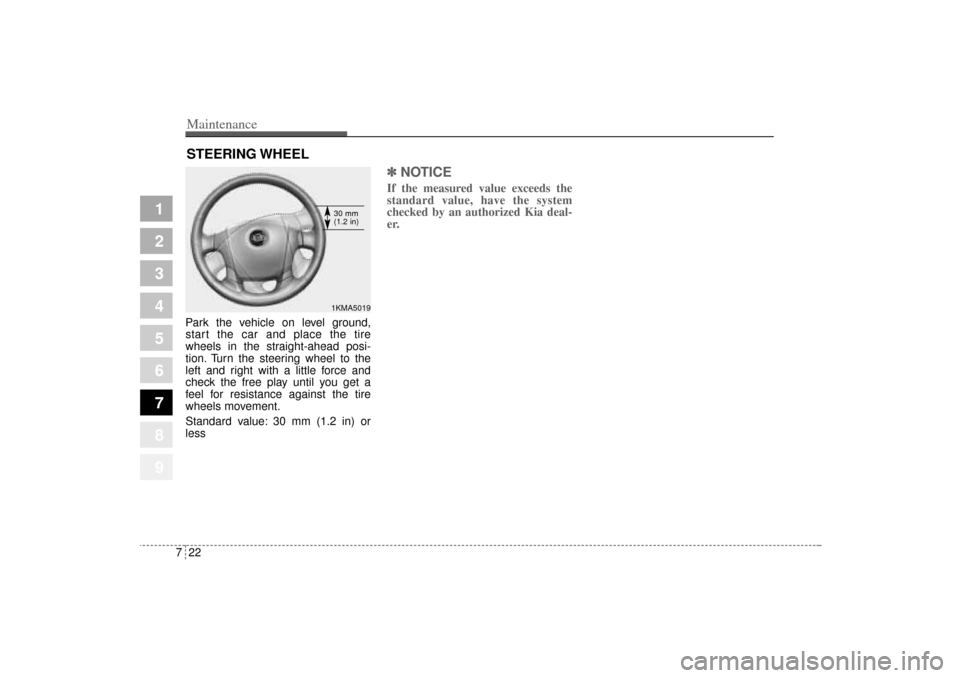
Maintenance22 7
1
2
3
4
5
6
7
8
9
STEERING WHEELPark the vehicle on level ground,
start the car and place the tire
wheels in the straight-ahead posi-
tion. Turn the steering wheel to the
left and right with a little force and
check the free play until you get a
feel for resistance against the tire
wheels movement.
Standard value: 30 mm (1.2 in) or
less
✽ ✽
NOTICEIf the measured value exceeds the
standard value, have the system
checked by an authorized Kia deal-
er.
1KMA501930 mm
(1.2 in)
KM CAN (ENG) 7.qxd 9/13/2004 4:47 PM Page 22
Page 316 of 354
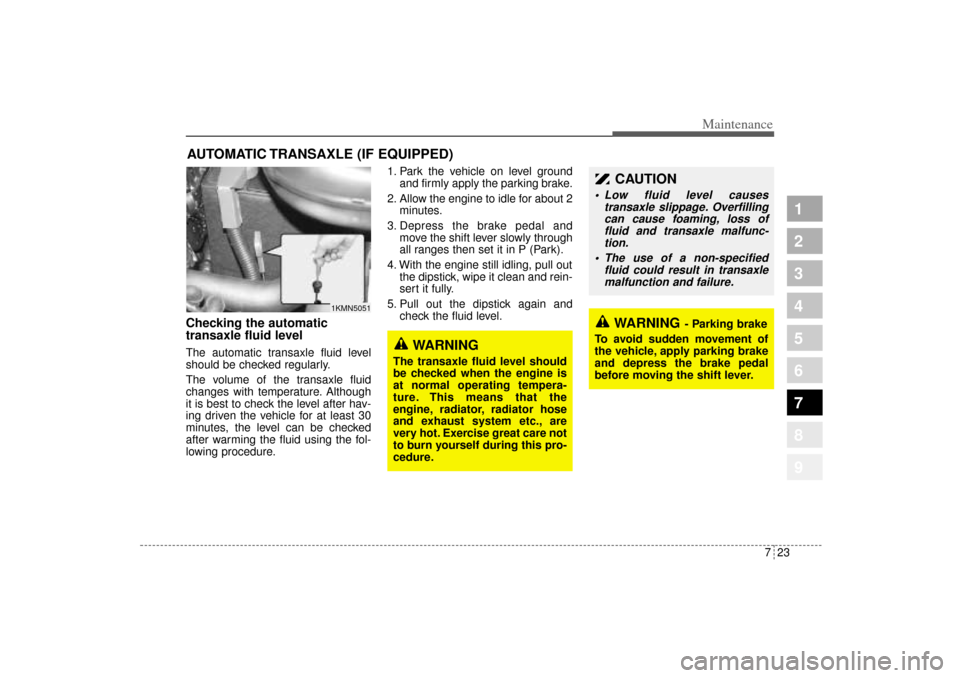
723
Maintenance
1
2
3
4
5
6
7
8
9
AUTOMATIC TRANSAXLE (IF EQUIPPED)Checking the automatic
transaxle fluid level The automatic transaxle fluid level
should be checked regularly.
The volume of the transaxle fluid
changes with temperature. Although
it is best to check the level after hav-
ing driven the vehicle for at least 30
minutes, the level can be checked
after warming the fluid using the fol-
lowing procedure.1. Park the vehicle on level ground
and firmly apply the parking brake.
2. Allow the engine to idle for about 2
minutes.
3. Depress the brake pedal and
move the shift lever slowly through
all ranges then set it in P (Park).
4. With the engine still idling, pull out
the dipstick, wipe it clean and rein-
sert it fully.
5. Pull out the dipstick again and
check the fluid level.
1KMN5051
WARNING
The transaxle fluid level should
be checked when the engine is
at normal operating tempera-
ture. This means that the
engine, radiator, radiator hose
and exhaust system etc., are
very hot. Exercise great care not
to burn yourself during this pro-
cedure.
CAUTION
Low fluid level causes
transaxle slippage. Overfilling
can cause foaming, loss of
fluid and transaxle malfunc-
tion.
The use of a non-specified
fluid could result in transaxle
malfunction and failure.
WARNING
- Parking brake
To avoid sudden movement of
the vehicle, apply parking brake
and depress the brake pedal
before moving the shift lever.
KM CAN (ENG) 7.qxd 9/13/2004 4:47 PM Page 23
Page 317 of 354
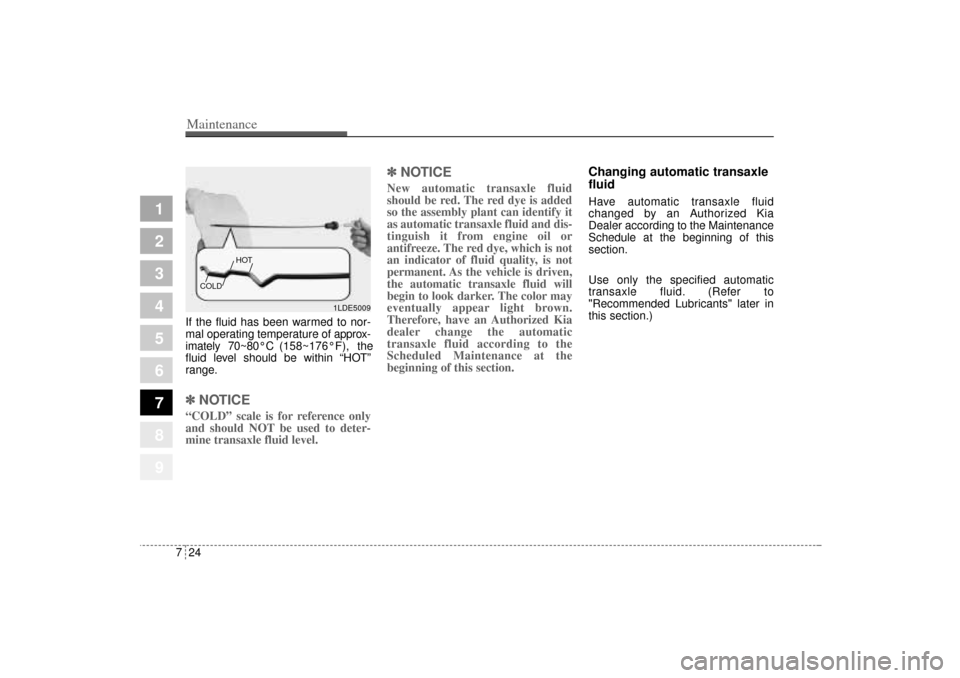
Maintenance24 7
1
2
3
4
5
6
7
8
9
If the fluid has been warmed to nor-
mal operating temperature of approx-
imately 70~80°C(158~176°F), the
fluid level should be within “HOT”
range.✽ ✽
NOTICE“COLD” scale is for reference only
and should NOT be used to deter-
mine transaxle fluid level.
✽ ✽
NOTICENew automatic transaxle fluid
should be red. The red dye is added
so the assembly plant can identify it
as automatic transaxle fluid and dis-
tinguish it from engine oil or
antifreeze. The red dye, which is not
an indicator of fluid quality, is not
permanent. As the vehicle is driven,
the automatic transaxle fluid will
begin to look darker. The color may
eventually appear light brown.
Therefore, have an Authorized Kia
dealer change the automatic
transaxle fluid according to the
Scheduled Maintenance at the
beginning of this section.
Changing automatic transaxle
fluidHave automatic transaxle fluid
changed by an Authorized Kia
Dealer according to the Maintenance
Schedule at the beginning of this
section.
Use only the specified automatic
transaxle fluid. (Refer to
"Recommended Lubricants" later in
this section.)
1LDE5009 COLDHOT
KM CAN (ENG) 7.qxd 9/13/2004 4:47 PM Page 24
Page 318 of 354
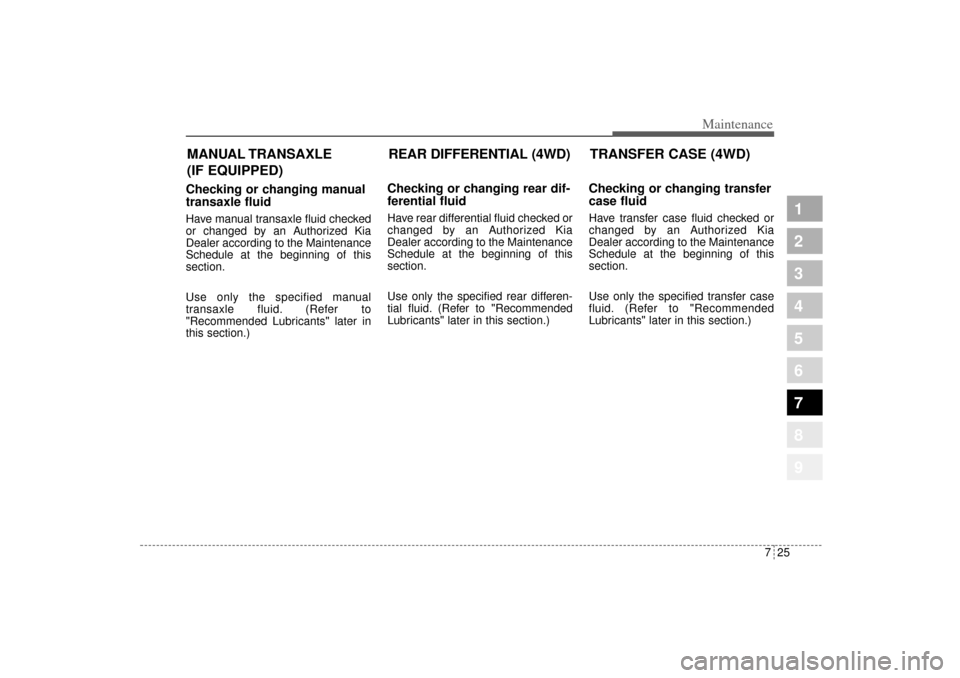
725
Maintenance
1
2
3
4
5
6
7
8
9
Checking or changing manual
transaxle fluidHave manual transaxle fluid checked
or changed by an Authorized Kia
Dealer according to the Maintenance
Schedule at the beginning of this
section.
Use only the specified manual
transaxle fluid. (Refer to
"Recommended Lubricants" later in
this section.)
Checking or changing rear dif-
ferential fluidHave rear differential fluid checked or
changed by an Authorized Kia
Dealer according to the Maintenance
Schedule at the beginning of this
section.
Use only the specified rear differen-
tial fluid. (Refer to "Recommended
Lubricants" later in this section.)
Checking or changing transfer
case fluidHave transfer case fluid checked or
changed by an Authorized Kia
Dealer according to the Maintenance
Schedule at the beginning of this
section.
Use only the specified transfer case
fluid. (Refer to "Recommended
Lubricants" later in this section.)
REAR DIFFERENTIAL (4WD)TRANSFER CASE (4WD) MANUAL TRANSAXLE
(IF EQUIPPED)
KM CAN (ENG) 7.qxd 9/13/2004 4:47 PM Page 25
Page 319 of 354
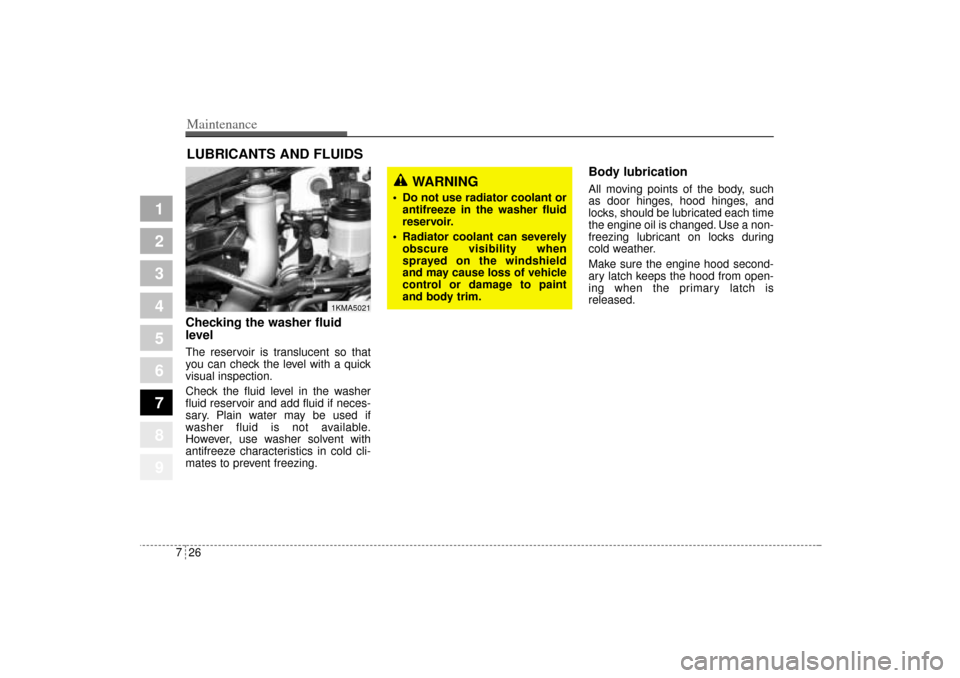
Maintenance26 7
1
2
3
4
5
6
7
8
9
LUBRICANTS AND FLUIDS Checking the washer fluid
level The reservoir is translucent so that
you can check the level with a quick
visual inspection.
Check the fluid level in the washer
fluid reservoir and add fluid if neces-
sary. Plain water may be used if
washer fluid is not available.
However, use washer solvent with
antifreeze characteristics in cold cli-
mates to prevent freezing.
Body lubrication All moving points of the body, such
as door hinges, hood hinges, and
locks, should be lubricated each time
the engine oil is changed. Use a non-
freezing lubricant on locks during
cold weather.
Make sure the engine hood second-
ary latch keeps the hood from open-
ing when the primary latch is
released.
1KMA5021
WARNING
Do not use radiator coolant or
antifreeze in the washer fluid
reservoir.
Radiator coolant can severely
obscure visibility when
sprayed on the windshield
and may cause loss of vehicle
control or damage to paint
and body trim.
KM CAN (ENG) 7.qxd 9/13/2004 4:47 PM Page 26
Page 320 of 354
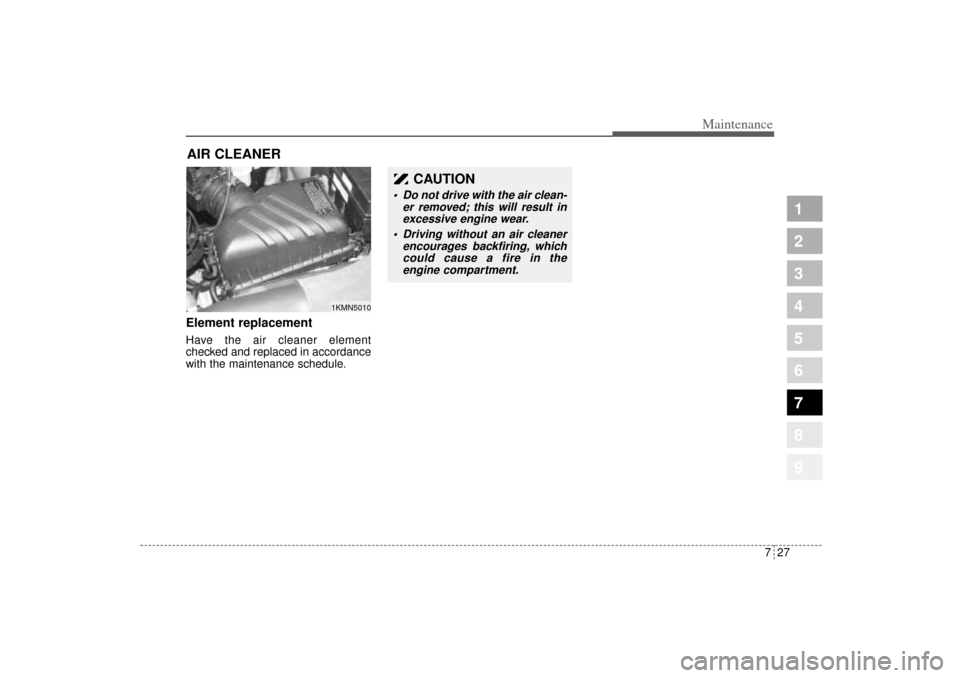
727
Maintenance
1
2
3
4
5
6
7
8
9
AIR CLEANER Element replacement Have the air cleaner element
checked and replaced in accordance
with the maintenance schedule.
1KMN5010
CAUTION
Do not drive with the air clean-
er removed; this will result in
excessive engine wear.
Driving without an air cleaner
encourages backfiring, which
could cause a fire in the
engine compartment.
KM CAN (ENG) 7.qxd 9/13/2004 4:47 PM Page 27